Product Safety - Electronic Column Lock System

| Subject: | 04006C -- Electronic Column Lock System |
| Models: | 1997-2004 Chevrolet Corvette Equipped with a Manual Transmission |
| 1997-2000 Chevrolet Corvette Equipped with an Automatic Transmission |
| 2001-2004 Chevrolet Corvette Equipped with an Automatic Transmission - European Export Only |
THIS BULLETIN CANCELS AND REPLACES BULLETIN 04006B, ISSUED NOVEMBER 2004.
THE SERVICE PROCEDURE FOR U.S. VEHICLES EQUIPPED WITH A MANUAL TRANSMISSION HAS BEEN REVISED. PLEASE REVIEW THIS NEW INFORMATION IMMEDIATELY.
ALL COPIES OF BULLETIN 04006B SHOULD BE DESTROYED.
Condition
General Motors has decided that a defect, which relates to motor vehicle safety, exists in certain 1997-2004 model year Chevrolet Corvette vehicles. When you remove the ignition key, the electronic column lock (ECL) system prevents turning of the steering wheel. When the vehicle is started, it unlocks the steering. Two conditions can prevent steering while the vehicle is moving:
- The vehicle is designed so that if the column fails to unlock when the vehicle is started, the fuel supply will be shut off if the driver tries to move the vehicle. If voltage at the powertrain control module is low or interrupted, however, the fuel shut off may not occur and the vehicle can be accelerated while the steering is locked.
- During quick cranks, the ECL lock pin may not withdraw fully and, in vehicles where there is abnormally low clearance to the lock plate, there may be contact between the pin and lock plate. This can cause a noise or ratcheting when the steering wheel is turned, or if there is insufficient clearance, the steering wheel cannot be turned.
If one of these conditions occurs, a crash could occur without warning.
Correction
Dealers are to remove the column lock plate on U.S. and Canadian vehicles equipped with an automatic transmission and U.S. vehicles equipped with a manual transmission. After the service correction, the steering column will no longer lock when the key is removed.
On Canadian and export vehicles equipped with a manual transmission, and export vehicles equipped with an automatic transmission, dealers are to 1) reprogram the PCM, and 2) verify there is adequate lock plate clearance and, if necessary, replace the lock plate. After the service correction, the steering column will continue to lock when the key is removed.
Vehicles Involved
Involved are certain 1997-2004 model year Chevrolet Corvettes equipped with a manual transmission, 1997-2000 Chevrolet Corvette equipped with an automatic transmission, and 2001-2004 Chevrolet Corvette equipped with automatic transmission (European export only), built within these VIN breakpoints:
Year | Division | Model | From | Through |
|---|---|---|---|---|
1997 | Chevrolet | Corvette | V5100001 | V5109707 |
1998 | Chevrolet | Corvette | W5100001 | W5131069 |
1999 | Chevrolet | Corvette | X5100001 | X5133283 |
2000 | Chevrolet | Corvette | Y5100001 | Y5133610 |
2001 | Chevrolet | Corvette | 15100001 | 15135601 |
2002 | Chevrolet | Corvette | 25100002 | 25135762 |
2003 | Chevrolet | Corvette | 35100003 | 35135465 |
2004 | Chevrolet | Corvette | 45100001 | 45120862 |
Important: Dealers should confirm vehicle eligibility through GMVIS (GM Vehicle Inquiry System) prior to beginning recall repairs. [Not all vehicles within the above breakpoints may be involved.]
For US
For dealers with involved vehicles, a Campaign Initiation Detail Report containing the complete Vehicle Identification Number, customer name and address data has been prepared and will be loaded to the GM DealerWorld, Recall Information website. Dealers that have no involved vehicles currently assigned, will not have a report available in GM DealerWorld.
For Canada
For dealers with involved vehicles, a Campaign Initiation Detail Report containing the complete Vehicle Identification Number, customer name and address data has been prepared, and is being furnished to involved dealers. Dealers that have no involved vehicles currently assigned, will not receive a report with the recall bulletin.
For IPC
For dealers with involved vehicles, a Campaign Initiation Detail Report containing the complete Vehicle Identification Number, customer name and address data has been prepared, and is being furnished to involved dealers. Dealers that have no involved vehicles currently assigned will not receive a report with the recall bulletin.
Parts Information
Parts required to complete this recall are to be obtained from General Motors Service Parts Operations (GMSPO). Please refer to your "involved vehicles listing" before ordering parts. Normal orders should be placed on a DRO = Daily Replenishment Order. In an emergency situation, parts should be ordered on a CSO = Customer Special Order.
Part Number | Description | Qty |
|---|---|---|
89023816 | Harness Kit, Strg Whl Theft Dtrnt Lk Shorting (U.S. manuals and all automatics except export vehicles) | 1 |
88952428 | Wire Kit, Strg Whl Theft Dtrnt Lk (1998-2000 Canadian and export manuals & export automatics) | 1 (if req'd) |
26056108 | Nut, Strg Whl | 1 (if req'd |
26094767 | Plate, Strg Shf Lk (Canadian manuals) | 1 (if req'd) |
88964588 | Plate, Strg Shk Lk (export) | 1 (if req'd) |
05694191 | Ring, Strg Shf Lk Plt Ret | 1 (if req'd) |
Service Procedure
The required repairs vary depending on the model year, build date, and whether Customer Satisfaction Program 01044 or Technical Service Bulletin 01-02-35-008 have previously been performed. Refer to the chart below to determine the correct repairs for the vehicle you are working on. After determining the correct repairs for the vehicle you are working on, proceed to the appropriate service procedure.
| PROCEDURE 1A | PROCEDURE 1B | PROCEDURE 2 | PROCEDURE 3 | |
|---|---|---|---|---|---|
Models | Install Wire Kit 89023816 | Install Wire Kit 88952428 | Reprogram | Functional Test | |
Tech 2 | Tech 2 w/SPX Tool | ||||
1997-2000 Automatic (except export vehicles) | |||||
All | X |
|
|
|
|
1997-2004 U.S. Manual | |||||
All | X |
|
|
|
|
1997 - All Canadian Manual & All Export | |||||
All |
|
| X |
| X |
1998 All Canadian Manual & All Export | |||||
Built through 5/25/98 |
|
| X |
| X |
Built on or after 5/26/98 and CSC 01044 was performed (V0743) |
|
| X | X |
|
Built on or after 5/26/98 and CSC 01044 was NOT performed (V0743) |
| X | X | X |
|
1999-2000 All Canadian Manual & All Export | |||||
CSC 01044 or TSB 01-02-35-008 (V0743 or N8505) was performed |
|
| X | X |
|
CSC1044 or TSB 01-02-35-008 was NOT performed (V0743 or N8505) |
| X | X | X |
|
2001-2004 All Canadian Manual & Export Manual & All European Export Automatic | |||||
All |
|
| X | X |
|
1997-2000 Corvettes Equipped With Automatic Transmission (Excludes Export Vehicles), and all U.S. Manual Transmission (Procedure 1A)
The following service procedure provides instructions for disconnecting the electric column lock (ECL) on vehicles equipped with an automatic transmission, and on all U.S. manual transmissions. DO NOT use this procedure on Canadian vehicles equipped with a manual transmission or on any export vehicles.
Tools Required
| • | J 1859-A Steering Wheel Puller |
| • | J 42120 Steering Wheel Puller Legs |
| • | J 23653 SIR, Steering Column Lock Plate Compressor |
| • | J 42137 Steering Column Lock Plate Compressor Adapter |
Important: Disregard all instruction sheets that may be in the harness kit, and follow the instructions provided in this service procedure.
- Turn the steering wheel so that the vehicle's front wheels are pointing straight ahead.
- Turn the ignition switch to the OFF position.
- Open the hood and disconnect the negative battery cable.
- Disengage the upper latches on the front floor kick-up panel on the passenger side.
- Lift the kick-up panel's lower edge out of the slots in the relay bracket.
- Remove the SDM fuse from the IP fuse block located behind the kick-up panel that was just removed.
- Using a flat-bladed tool, carefully pry the IP courtesy lamp assembly from the driver's side lower closeout panel.
- Remove the push-on retaining nut from the steering column bracket stud.
- Release the driver's side lower closeout panel push-in retainers from the IP lower support beam.
- Insert the IP courtesy lamp assembly up through the opening in the closeout panel.
- Lower and remove the closeout panel. Release the notch in the right-hand forward edge of the closeout panel from the tab on the accelerator pedal bracket.
- Remove the connector position assurance (CPA) from the driver's yellow 2-way air bag connector located at the base of the steering column and disconnect the connector.
- Remove the CPA from the passenger yellow 2-way air bag connector, also located at the base of the steering column, and disconnect the connector.
- Remove the screws attaching the driver's inflator module to the steering wheel (3) and pull the module away from the steering wheel.
- Disconnect the SIR electrical connector (2) from the backside of the module, the horn wiring harness connector (6) from the steering column, and the ground wire (5) from the steering column. Remove the module.
- Remove the nut attaching the steering wheel to the column and discard the nut.
- Using tool J 1859-A, Steering Wheel Puller, and J 42120, Steering Wheel Puller Legs, remove the steering wheel from the column.
- Using a small flat-bladed screwdriver, release the locking tab from the tilt lever handle and pull the lever straight out.
- Using a small flat-bladed screwdriver, pry the lower edge of the combination fog lamp/trunk release switch to release the locking tab. Disconnect the electrical connector from the switch. Repeat this step on the inside air temperature grill located to the right side of the steering column.
- Remove the driver's side knee bolster trim panel retaining screw, located behind the area where the combination fog lamp/trunk release switch is installed. Repeat this step on the screw located in the inside air temperature cavity.
- Remove the driver's side knee bolster trim panel lower retaining screws.
- Grasp the trim panel at the side edges and firmly pull rearward to release the locking tabs and remove the panel.
- If equipped, disconnect the electrical connector from the inside air temperature sensor.
- Remove the two screws that attach the lower steering column cover (3) to the upper (1).
- Remove the one screw that attaches the upper steering column cover to the column and remove the upper cover.
- Remove the snap ring and SIR coil from the steering column.
- Using J 23653-SIR (2), remove the retaining ring and the lock plate (1) and discard both.
- Align and position the cam orientation plate (1), included in the kit, on the steering column shaft.
- Using J 23653-SIR and J 42137 (1), install the cam orientation plate and the new retaining ring included in the recall kit. The cam orientation plate replaces the lock plate removed in the previous step.
- Position the SIR coil on the steering column and install the snap ring.
- Disconnect the electrical connector from the ECL, located on the right lower side of the steering column.
- Attach the NEW relay (1) and harness, included in the kit, to the left IP brace as shown and secure with plastic tie straps.
- Route the NEW relay harness over the knee bolster.
- Connect one end of the NEW relay harness into the connector on the ECL. Connect the other end on the NEW relay harness into the connector that was disconnected from the ECL in Step 31.
- Install the upper steering column cover and install the attaching screw.
- Install the lower steering column and attaching screws.
- If equipped, connect the electrical connector to the inside air temperature sensor located on the knee bolster trim panel.
- Install the knee bolster trim panel and press firmly to engage the locking tabs.
- Install the lower retaining screws and the screw located behind the combination fog lamp/trunk release switch, and the inside air temperature sensor grill.
- Connect the electrical connector to the combination fog lamp/trunk release switch and install the assembly into the opening in the IP. Press firmly to secure. Repeat this step on the inside air temperature sensor grill.
- Slide the tilt lever in the steering column until the locking tab clicks into place.
- Remove the inflatable restraint module retaining screws from the steering wheel.
- Position, align, and press the steering wheel onto the steering column shaft.
- Install a NEW steering wheel set nut on the steering column shaft.
- Install the retaining screws removed from the steering wheel into the backside of the inflatable restraint module.
- Position the inflatable restraint module to the steering wheel and connect the SIR electrical connector, the horn wiring harness connector to the steering column, and the ground wire to the column.
- Install the inflatable restraint module on the steering wheel by pushing on both the right and left sides of the module until the retaining screws snap into place.
- Connect the passenger yellow 2-way air bag connector located at the base of the steering column, and install the CPA.
- Connect the driver's yellow 2-way air bag connector located at the base of the steering column and install the CPA.
- Position the driver's side lower closeout panel below the IP and install the courtesy lamp.
- Raise the closeout panel to the IP and engage the push-in retainers to the IP lower support beam.
- Align the right-hand forward edge of the panel to the tab on the accelerator pedal bracket. Push up to secure.
- Install the push-on retaining nut to the steering column bracket stud.
- Install the SDM fuse.
- Position the kick-up panel to the opening in the floor and insert the lower tabs into the slots in the multi-use bracket.
- Close the panel and latches.
- Connect the negative battery cable and close the hood.
- Verify that the ECL and relay are synchronized:
- Start the engine and verify that the steering column is unlocked.

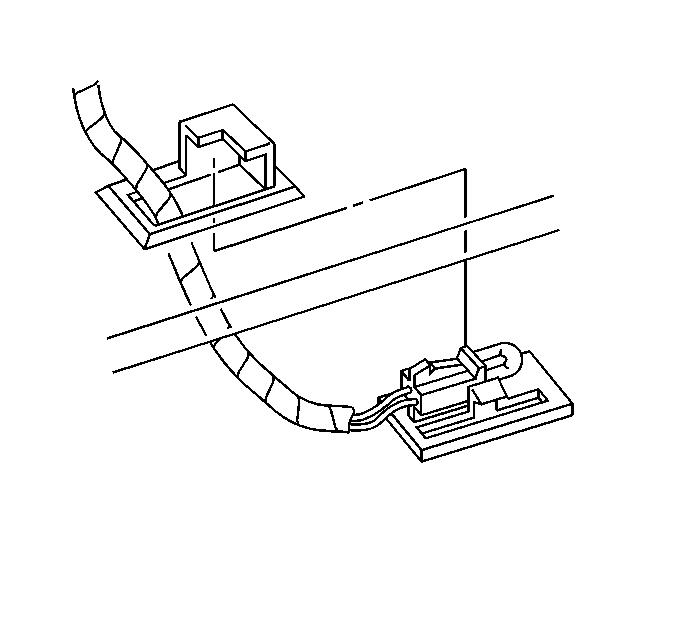

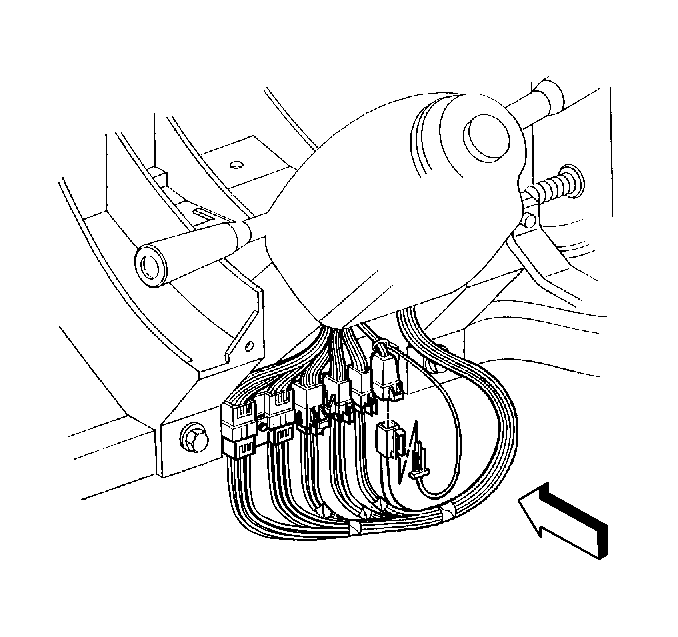

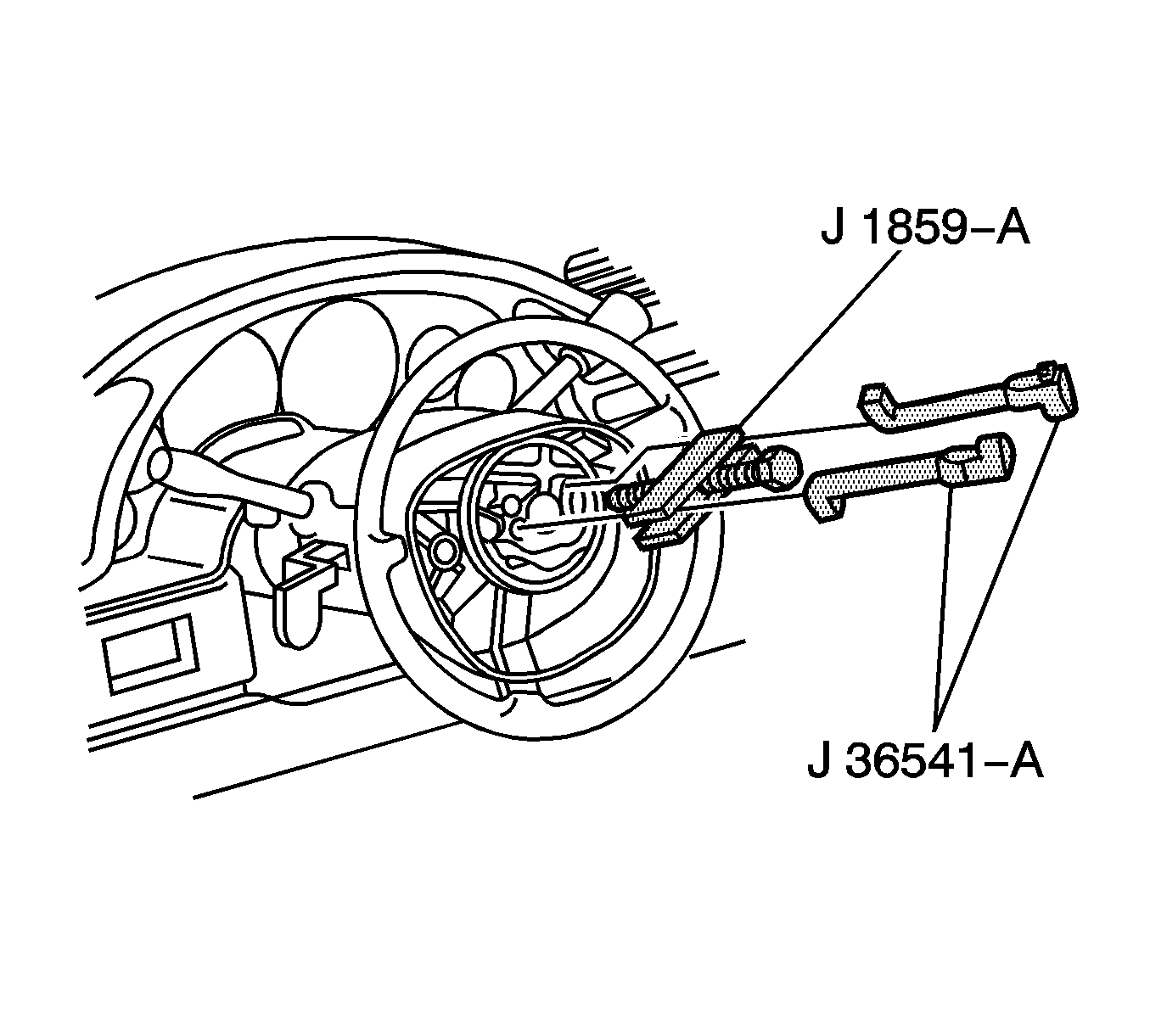

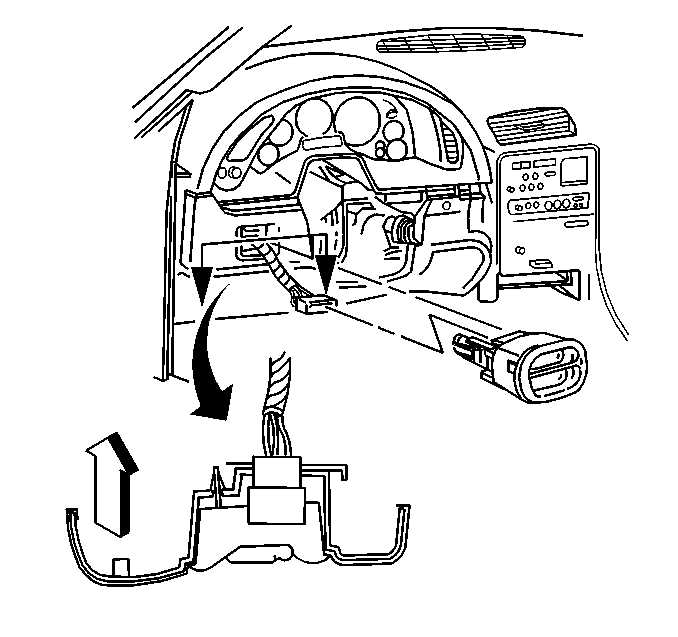
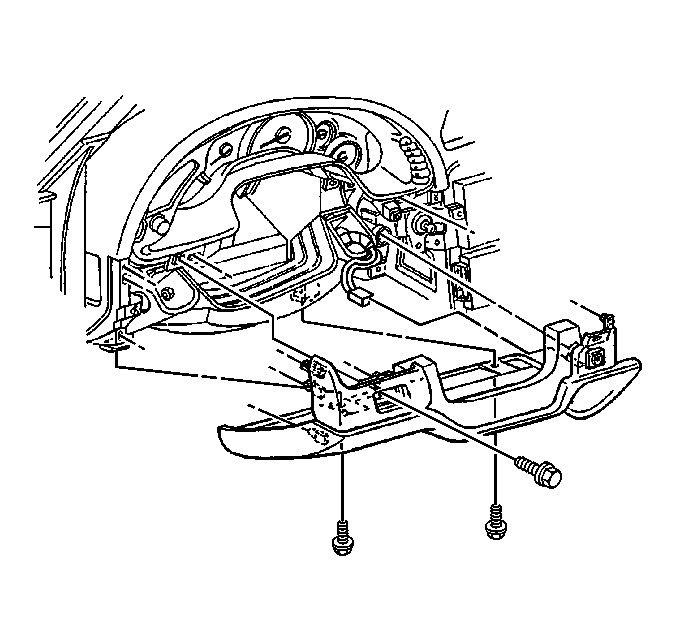
Important: When removing the driver's side knee bolster trim panel as described below, care must be taken not to damage the console trim plate as the knee bolster trim panel tucks in behind the console trim plate.

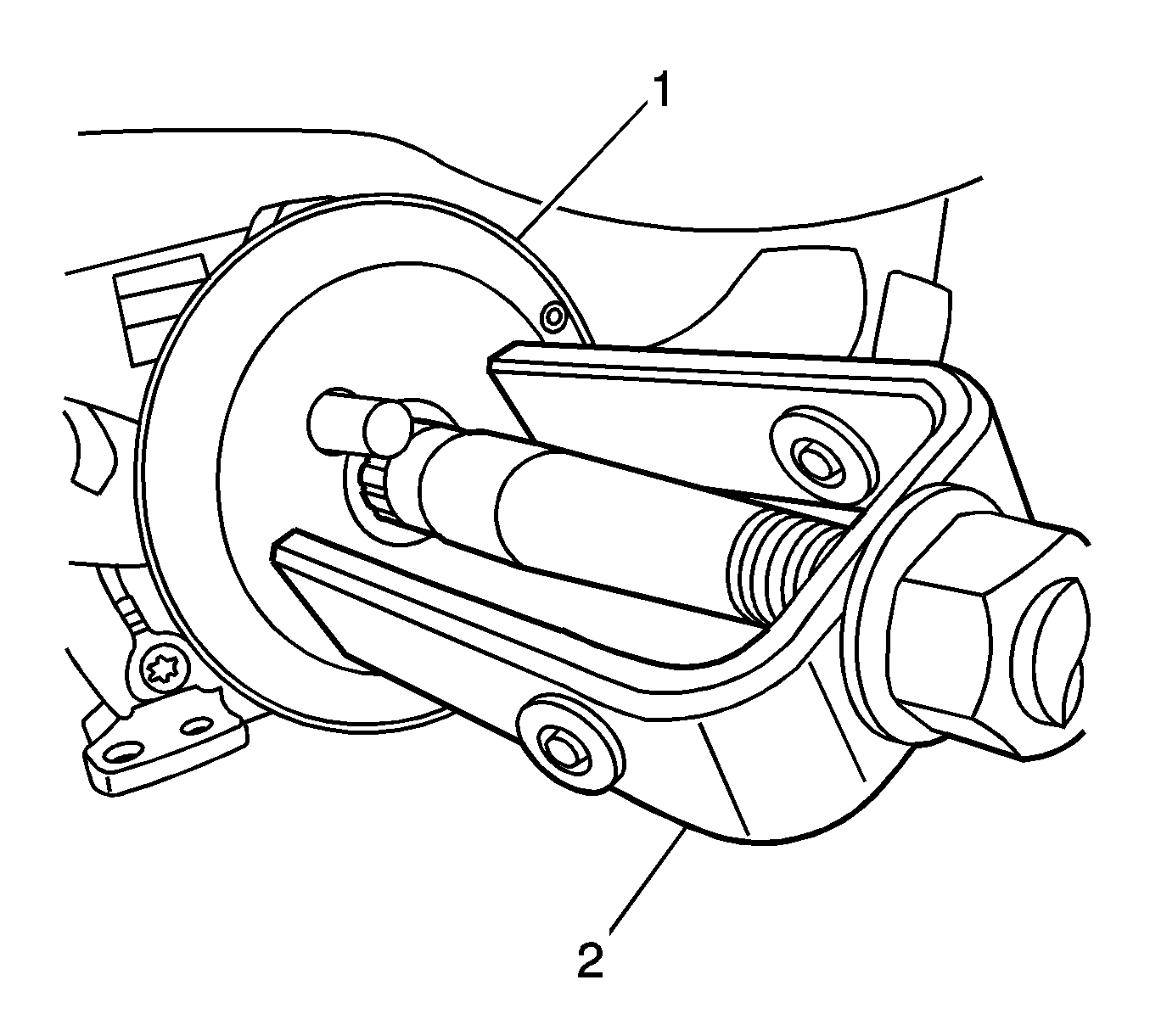
Notice: Tool J 23653-SIR MUST be used when removing the retaining ring and lock plate in the next step.
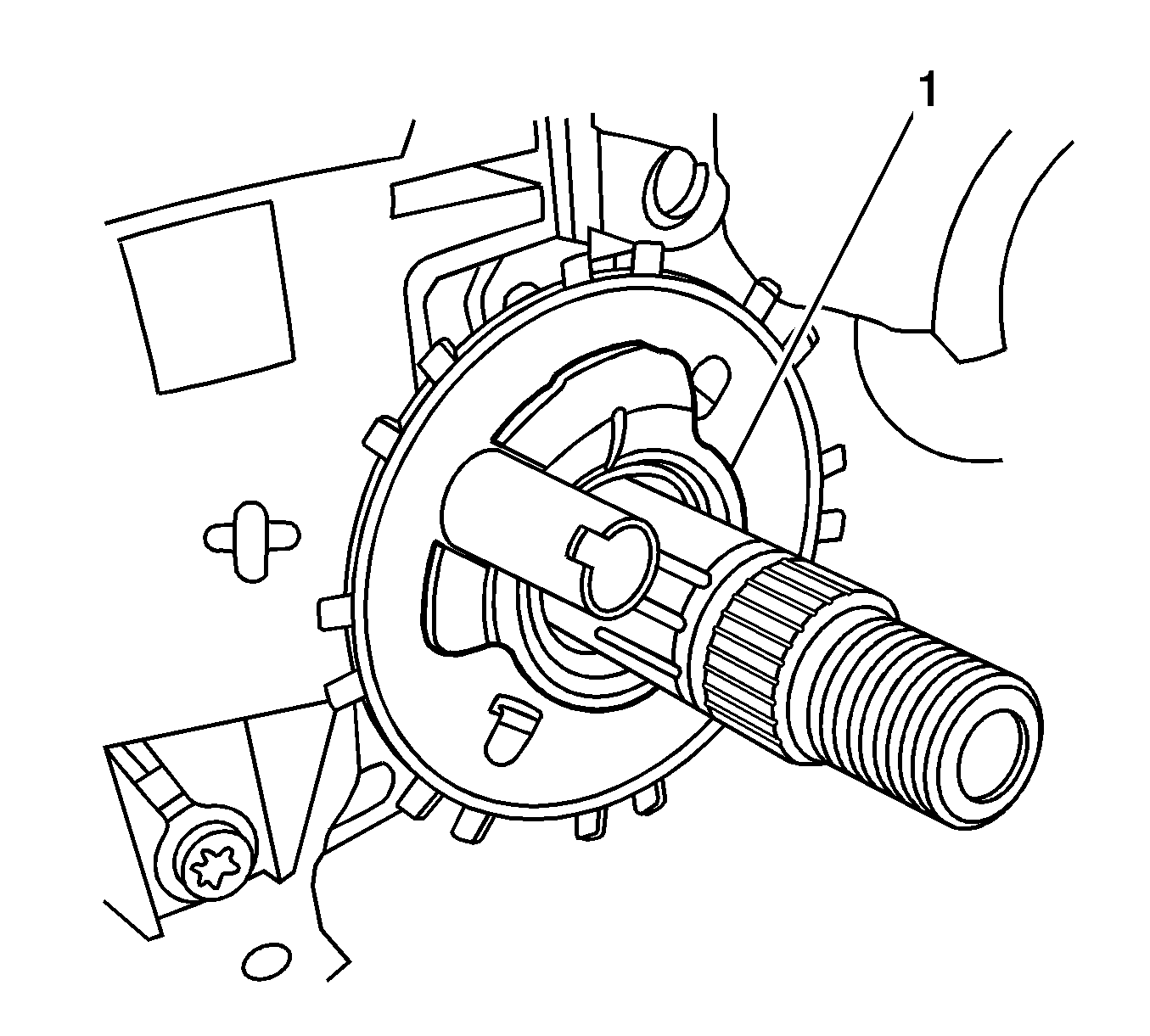
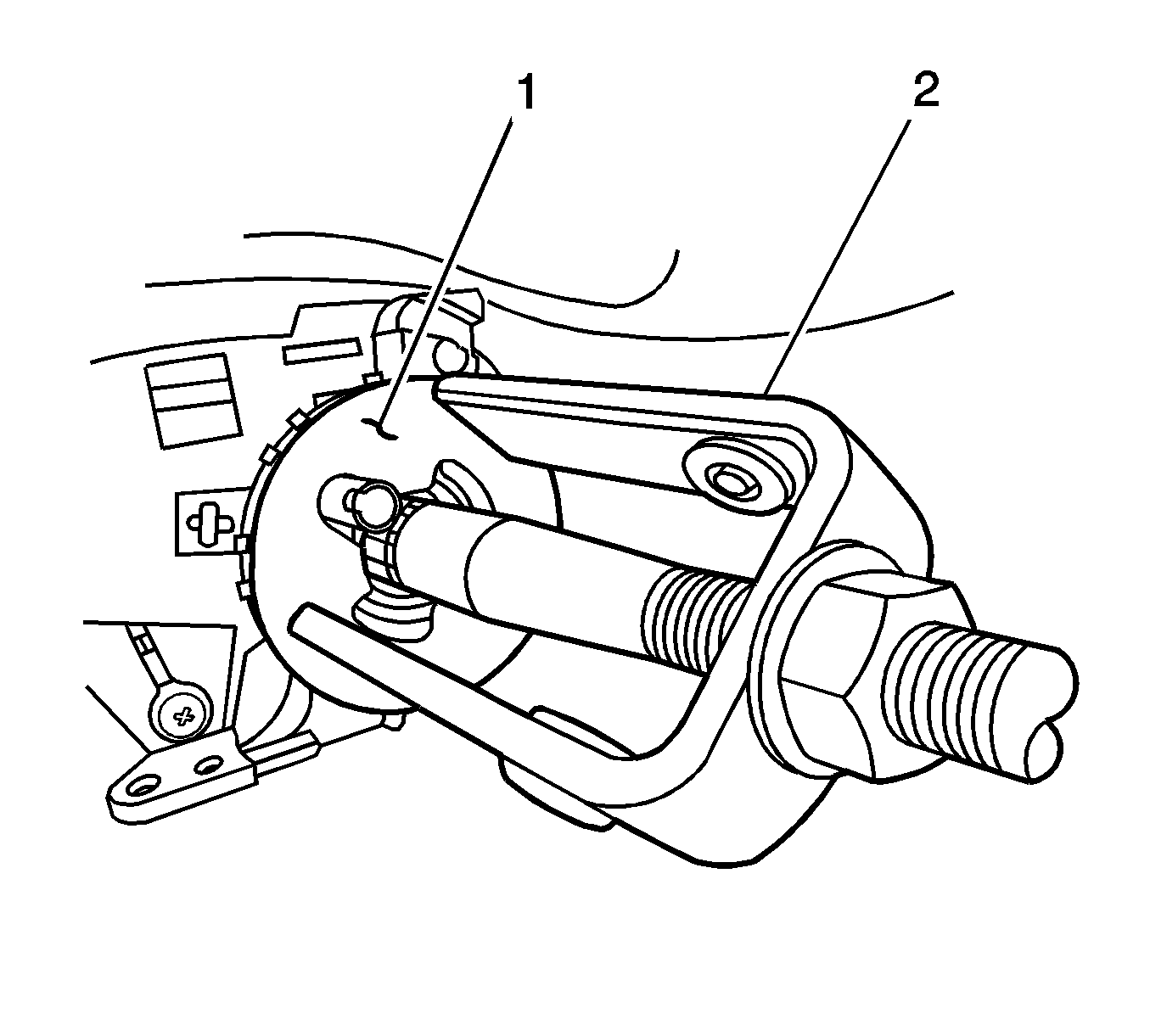
Notice: When installing the cam orientation plate in the next step, a NEW retaining ring must be used. Do not reuse the original retaining ring.
J 23653-SIR and J 42137 MUST be used when installing the orientation plate and retaining ring in the next step. Failure to use these tools may result in damage to the cam orientation plate, retaining ring or steering column components.Important: The connectors on the NEW relay harness are specific and MUST be connected correctly in the next steps. When connected, the new connection becomes J165/P165.
Tighten
Tighten the screw to 1.9 N·m(17 lb in).
Tighten
Tighten the screws to 4 N·m(35 lb in).
Tighten
Tighten the screws to 1.8 N·m(16 lb in).
Tighten
Tighten the nut to 41 N·m(30 lb ft).
Tighten
Tighten the screws to 6 N·m(53 lb in).
Depending on the position of the relay and the ECL bolt when the key (ignition switch) is first turned to the ON position, you may receive the message "Pull Key and Wait 10 Sec."
| • | If you do NOT receive this message, the ECL and relay ARE synchronized. No further action is required. |
| • | If you DO receive this warning message, the ECL and relay are NOT synchronized. To synchronize, turn the ignition switch to the OFF position and REMOVE THE KEY from the switch (lock cylinder). Wait a MINIMUM of 10 seconds, re-insert the key, and turn to the ON position. From this point on, the ECL and relay should be synchronized. |
1997-2004 Canadian & Export Corvettes with manual transmissions / 1997-2000 EXPORT vehicles with automatic transmissions / 2001-2004 EUROPEAN EXPORT vehicles with automatic transmissions
The required repairs vary depending on the model year, build date, and what repairs (Customer Satisfaction Campaign 01044 or Tehcnical Service Bulletin 01-02-35-008) have been previously performed. Refer to the chart at the beginning of the service procedure in this bulletin to determine the correct repairs for the vehicle you are working on.
If necessary, check the "Claim History" in the "Summary" section in the GM Vehicle Inquiry System (GMVIS) to determine whether Customer Satisfaction Campaign (CSC) 01044 or Technical Service Bulletin (TSB) 01-02-35-008 has been performed on a vehicle. DO NOt use the "Required Field Action" section to determine whether Customer Satisfaction Campaign 01044 has been performed. All vehicles involved in that Campaign were listed as closed when the campaign was cancelled. If either has been performed, labor operation V0743 (CSC 01044) or N8505 (TSB 01-02-35-008) will be listed.
After determining the required repairs for the vehicle you are working on , proceed to the appropriate Service Procedures in this bulletin for instructions.
Important: If the vehicle requires the installation of a "Wire/Relay Kit", that must be done first, followed by the "Reprogram" followed by the "Functional Test". If the vehicle does not require the "Wire/Relay Kit," then you should first perform the "Reprogram" followed by the "Functional Test." Remember, you must complete "all" repairs listed for the vehicle being worked on in order to complete this recall.
Installing Wire and Relay Kit, P/N 88952428 (Procedure 1B)
This procedure should ONLY be done if the vehicle you are working on has NOT had Customer Satisfaction Campaign (CSC) 01044 or Technical Service Bulletin (TSB) 01-02-35-008 performed. See the information above.
- Turn the steering wheel so that the vehicle's front wheels are pointing straight ahead.
- Turn the ignition switch to the OFF position.
- Open the hood and disconnect the negative battery cable.
- Disengage the upper latches on the front kick-up panel on the passenger side.
- Lift the kick-up panel's lower edge out of the slots in the relay bracket.
- Locate the ECL relay, which is above the body control module (BCM).
- Remove the connector position assurance (CPA) clip from the back of the ECL relay connector.
- Remove the ECL relay harness from the backside of the relay assembly.
- Remove the ECL relay from the connector and discard the relay.
- Using the appropriate terminal release tool, remove the ORANGE wire from position C1 on the ECL relay connector.
- Using the appropriate terminal release tool, remove the WHITE wire from position A2 on the ECL relay connector.
- Swap the two terminal positions and re-insert them so that the ORANGE wire is now in position A2 and the WHITE wire is now in position C1.
- Connect the remaining purple wire and terminal on the jumper harness into position B2 in the ECL relay connector.
- Install the NEW single poke, double throw relay, included with the jumper harness kit, to the ECL connector.
- Release the retainer holding the BCM and reposition the module for access to the electrical connectors.
- Disconnect the green 16-way connector from the BCM. The above illustration is rotated approximately 90 degrees.
- Using the appropriate terminal release tool, remove the purple wire and terminal from cavity A6 of the BCM connector.
- Slide the piece of heat shrink tubing on the jumper harness, included in kit P/N 88952428.
- Connect the female terminal and wire removed from the BCM connector to the male terminal on the jumper harness.
- Slide the heat shrink tubing over the two terminals that you just connected together and apply heat as necessary to shrink/seal the tubing.
- Install the female terminal on the jumper harness into cavity A6 in the BCM connector.
- Reconnect the green 16-way connector to the BCM.
- Position the BCM to the electrical panel and secure with the retainer.
- Attach the new purple wire to other wires in the harness using black electrical tape.
- Connect the negative battery cable to the battery.
- Proceed to the section titled "Service Reprogramming". After reprogramming has been completed, install the lower edte of the kick-up panel in the slots in the relay bracket and engage the upper latches or hook and loop fasteners.

Important: The Electric Column Lock (ECL) relay described in the next step can be identified by the four wires that connect to it. Prior to the modification being done, there should be two ORANGE wires, one DARK GREEN, and one WHITE wire. If there is also a purple wire (a total of five wires), then the Wire and Relay Kit has already been installed and you shoudl proceed to the section titled "Service Reprogramming."
Important: The relay being removed in the next step is a single pole, single throw design. With the wiring modifications being made in the next steps, a single pole, double throw relay is required. Only the new relay included with the humper harness can be used once the wiring modifications have been made.
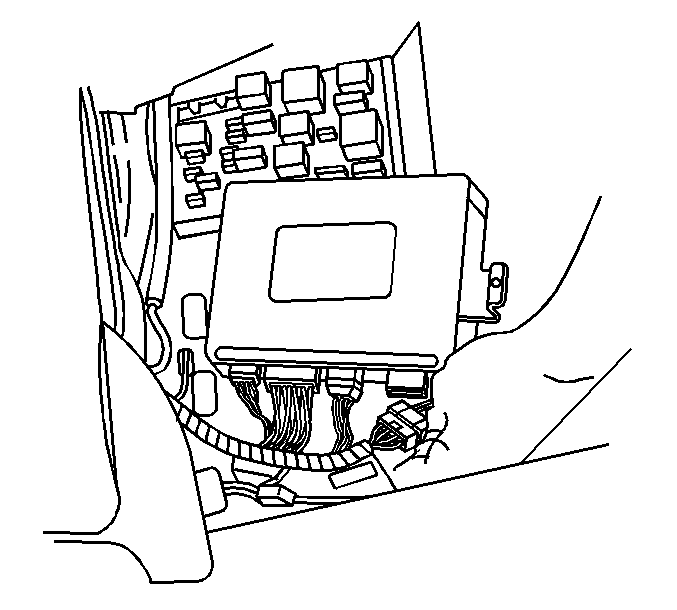
Service Reprogramming (Procedure 2)
Important: In order to perform the following powertrain control module (PCM) reprogramming procedure, your Tech 2 must be updated with software version 24.008 or later. Please note that vehicles repaired previously using software version 24.004 or later do not need to be reprogrammed again. If your Tech 2 does not have the necessary software, you will need to update it before proceeding. Also, you must review Service Bulletin #02-06-04-022A (Info-PCM Reprogramming and Data Line Diagnosis Using J 42236-A) before beginning to reprogram the PCM.
- Turn the ignition switch to the ON position.
- Connect the Tech 2 to the vehicle's diagnostic link connector (DLC), power it up and press ENTER.
- Select SERVICE PROGRAMMING for the PCM.
- Follow the on-screen instructions and prompts. If necessary, refer to up-to-date Techline equipment user instructions.
- After completion of the reprogramming proceed to the next section titled "Functional Test of ECL."
Important: If the vehicle is a 1997 or 1998 built before 5/26/98, do not reassemble the body control module (BCM) area of the vehicle until after the "Functional Test of ECL" has been completed. Access to this area will be required when installing EL 47728, electronic column lock tester.
Functional Test of ECL (Procedure 3)
Tools Required
EL 47728 Electronic Column Lock Tester (for 1997 and 1998 models built before 5/26/98)
Important: Depending on conditions that may occur during the functional test, the Tech 2 may display various messages (Sequence Number). Definitions for the different sequence messages are at the end of the functional test procedure in this bulletin.
Important: In order to perform the following procedure, your Tech 2 must be updated with software version 24.008 or later. If your Tech 2 does not have the necessary software, you will need to update it before proceeding.
- Raise the vehicle on a suitable lift so that the front wheels are off the ground by a few inches.
- Position the front tires/wheels in the straight-ahead position.
- Open the hood and connect a battery charger to the vehicle. Operate the charger at a Low or Medium charge rate.
- Turn the ignition switch to the ON position.
- Close both windows and turn off all accessories (radio, HVAC) and lighting.
- While listening carefully, slowly turn the steering wheel to the full left and then back to the full right. Then return the front tires/wheels to the straight-ahead position.
- Turn the ignition switch to the OFF position and REMOVE THE KEY.
- Verify that the steering column LOCKED and that no ECL related messages are displayed on the Driver Information Center. It may be necessary to turn the steering wheel slightly in order for the ECL to engage in one of the openings in the lock plate.
- If the vehicle is a 1997 or 1998 built before 5/26/98, disconnect the upper pink 32-way connector (C2) and the lower green 16-way connector (C3) from the BCM. Attach the tester to the BCM and to the vehicle's wiring harness pink and green connectors.
- Connect the Tech 2 to the vehicle's DLC, power it up, and press ENTER. If necessary, refer to up-to-date Techline equipment user instructions.
- Select DIAGNOSTICS.
- Enter MODEL YEAR followed by PASSENGER CAR, followed by BODY.
- Select "Y" for the product lne followed by the appropriate body style (coupe, convert, etc.).
- Select BODY CONTROL MODULE, followed by SPECIAL FUNCTIONS, followed by OUTPUT CONTROL followed by MISCELLANEOUS TESTS.
- Select STEERING COL. LOCK FUNCTIONAL TEST.
- Open the hood and connect a battery charger to the vehicle. Operate the charger at a Low or Medium charge rate.
- Follow the on-screen instructions.
- Results of Functional Test:
- Press the "EXIT" button on the Tech 2 as necessary and disconnect it from the vehicle.
- Disconnect the battery charger from the vehicle and close the hood.
- If the vehicle is a 1997 or 1998 built before 5/26/98, disconnect the EL 47728 from the BCM and the vehicle's wiring harness. Then reconnect the vehicle's wiring harness to the BCM. Also, reassemble the BCM area of the vehicle at this time.
- Using the Tech 2, check and erase any current and history codes that may be stored in the BCM.
Important: In order to hear a possible interference between the ECL and lock plate in the steering column during the functional test, the area in and around the vehicle must be as quiet as possible in the next few steps.
| • | If you heard any ratcheting, ticking, scraping or other type sounds coming from the steering column, locate the source and correct before proceeding. |
| • | If you did NOT hear any ratcheting, ticking, scraping or other type sounds, continue to the next step. |
Important: The ignition key must be removed from the igniton switch in the next step.
| • | If the column did not lock, inspection for installation of a Cam Orientation Plate and the related wiring harness that are to be used only on non-export vehicles with AUTOMATIC transmissions. |
| • | Inspect for installation of aftermarket wiring/relay that override the operation of the steering column lock. |
| • | Repair the ECL system per Service Manual procedures before proceeding with this functional test. |
Important: On 1997 and 1998 models built BEFORE 5/26/98, EL 47728, electronic column lock tester must be installed in the vehicle in the next step.
Important: The test is only for vehicles with manual transmissions and EXPORT vehicles with automatic transmissions. Do NOT use this test on non-export vehicles with automatic transmissions.
Important: The battery voltage must be maintained between 13.0 and 15.0 volts when performing the functional test in the next steps. Becuase the engine is NOT to be running during the test, a battery charger must be connected to the vehicle in the next step. The battery charger should be operated at a Low or Medium charge rate. Do NOT operate the charger on a "Fast Charge" or "HIGH" charge rate. Doing so may exceed the 15.0 volt limit for the test.
| • | If you could hear or feel any type of ratcheting, ticking, or scraping sound (that wasn't heard earlier) when turning the steering wheel, the steering column lock plate, retaining ring, and steering wheel retaining nut must be replaed. Proceed to the section in this bulletin titled, "Lock Plate, Retaining Ring, and Nut Replacement." |
| • | If you could NOT hear or feel any type of ratcheting, ticking, or scraping sound when turning the steering wheel, no further repairs are required. Proceed to the next step. |
Important: On 1997 and 1998 models built BEFORE 5/26/98, EL 47728, electronic column lock tester must be removed from the vehicle in the next step. If it is not removed, the ECL and starter will not operate with the ignition key.
Important: When using EL 47728, some codes may be set in the BCM. These codes must be cleared in the next step.
Tech 2 Message Definitions
| • | Test Won't Start "Battery voltage needs to be between 13.0 and 15.0 in order to run test." |
| Connect the battery charger to the battery and operate the charger at a Low or Medium rate. DO NOT operate the charger on High or Fast Charge. |
| • | Test Terminated Sequence 1 "Make sure steering is not side loaded." |
| The front tires are turned tightly left or right causing the steering column to be under load and the ECL pin to bind in lock plate. To correct, turn the steering wheel so that the tires are straight ahead and restart the test. |
| • | Test Terminated Sequence 2 "Remove key from ignition switch." |
| The test cannot run with the key in the ignition switch. To correct, remove the key and restart the test. |
| • | Test Terminated Sequence 3 Not applicable. |
| Depending on the conditon, different messages may be displayed in Sequence 4. |
| • | Test Terminated Sequence 4 "Test Terminated" or "Check for automatic transmission (non-export) steering wheel theft deterrent lock shorting harness" being installed. |
| The harness is only for use on non-export vehicles with automatic transmissions. It is NOT for use on manual transmission vehicles. If the harness has been installed, it must be removed. If the harness isn to there, replace the ECL. |
| • | Test Terminated Sequence 5 "Test Terminated" |
| Check for the automatic transmission (non-export) steering wheel theft deterrent lock shorting harness being installed. The harness is only for use on non-export vehicles with automatic transmissions. It si NOT for use on manual transmission vehicles or EXPORT automatic transmission vehicles. If the harness has been installed, it must be removed. If the harness is not there, replace the ECL. |
Lock Plate, Retaining Ring, and Nut Replacement
The following procedure should only be performed if the results of the Functional Test direct you to this section.
| • | J 1859-A Steering Wheel Puller |
| • | J 42120 Steering Wheel Puller Legs |
| • | J 23653-SIR Steering Column Lock Plate Compressor |
- Turn the ignition switch to the OFF position.
- Disconnect the negative battery cable.
- Disengage the upper latches or hook and loop fasteners on the front floor kick-up panel on the passenger side.
- Lift the kick-up panel's lower edge out of the slots in the relay bracket.
- Remove the SDM fuse from the IP fuse block located behind the kick-up panel that was just removed.
- Using a flat-bladed tool, carefully pry the IP courtesy lamp assembly from the driver's side lower closeout.
- Remove the push-on retaining nut from the steering column bracket stud.
- Release the driver's side lower closeout panel push-in retainers from the IP lower support beam.
- Insert the IP courtesy lamp assembly up through the opening int he closeout panel.
- Lower and remove the closeout panel. Release the notch in the right-hand forward edge of the closeout panel from the tab on the accelerator pedal bracket.
- Removde the connector position assurance (CPA) from the driver's yellow 2-way air bag connector located at the base of the steering column and disconnect the connector.
- Remove the CPA from the passenger yellow 2-way air bag connector, also located at the base of the steering column, and disconect the connector.
- Remove the screws attaching the driver's inflator module to the steering wheel and pull the module away from the steering wheel.
- Disconnect the SIR electrical connector from the backside of the module, the horn wiring harness connector from the steering column, and the ground wire from the steering column. Remove the module.
- Remove the nut attaching the steering wheel to the column and discard the nut.
- Using tool J 1859-A, Steering Wheel Puller, and J 42120, Steering Wheel Puller Legs, remove the steering wheel from the column.
- Using a small flat-bladed screwdriver, release the locking tab from the tilt lever handle and pull the lever straight out.
- Using a small flat-bladed screwdriver, pry the lower edge of the combinatino fog lamp/trunk release switch to release the locking tab. Disconnect the electrical connector from the switch. Repeat this step on the inside air temperature sensor grill located to the right side of the steering column.
- Remove the driver's side knee bolster trim panel retaining screw, located behind the area where the combinatin fog lamp/trunk release switch is installed. Repeat this step on the screw locoated in the inside air temperature sensor cavity.
- Remove the driver's side knee bolster trim panel lower retaining screws.
- Grasp the trim panel at the side edges and firmly pull rearward to release the locking tabs and remove the panel.
- If equipped, disconnect the electrical connector from the inside air temperature sensor.
- Remove the two screws that attach the lower steering column cover (3) to the upper (1).
- Remove the one screw that attaches the upper steering column cover to the column and remove the upper cover.
- Remove the snap ring and SIR coil from the steering column.
- Using the J 23653-SIR (2), remove the retaining ring and the lock plate (1) and discard both.
- Position the new lock plate and retaining ring on the steering column shaft.
- Using J 23653-SIR and J 42137 (included with J 23653-SIR), install the new lock plate and new retaining ring. Use J 42137 to slide the retaining ring intot he groove on the shaft. Make sure the retaining ring is completely seated in the groove all the way around the shaft.
- Position the SIR coil on the steering column and install the snap ring.
- Install the upper steering column cover and install the attaching screw.
- Install the lower steering column and attaching screws.
- If equipped, connect the electrical connector to the inside air temperature sensor located on the knee bolster trim panel.
- Install the knee bolster trim panel and press firmly to engage the locking tabs.
- Install the lower retaining screws and the screws located behind the combination fog lamp/trunk release switch, and the inside air temperature sensor grill.
- Connect the electrical connector to the combination fog lamp/trunk release switch and install the assembly into the opening in the IP. Press firmly to secure. Repeat this step on the inside air temperature sensor grill.
- Slide the tilt lever in the steering column until the locking tab clicks into place.
- Remove (pull) the two inflatable restraint module retaining screws from the steering wheel.
- Position, align, and press the steering wheel ontot he steering column shaft.
- Install a NEW steering wheel set nut on the steering column shaft.
- Install the two retaining screws removed from the steering wheel into the backside of the inflatable restraint module.
- Position the inflatable restraint module to the steering wheel and connect the SIR electrical connector, the horn wiring harness connector to the steering column, and the ground wire to the column.
- Install the inflatable restraint module on the steering wheel by pushing on both the right and left sides of the moduel until the retaining screws snap into place.
- Connect the passenger yellow 2-way air bag connector located at the base of the steering column, and install the CPA.
- Connect the driver's side yellow 2-way air bag connector located at the base of the steering column, and install the CPA.
- Position the driver's side lower closeout panel below the IP and install the courtesy lamp.
- Raise the closeout panel to the IP and engage the push-in retainers to the IP lower support beam.
- Align the right-hand forward edge of the panel to the tab on the accelerator pedal bracket. Push up to secure.
- Install the push-on retaining nut to the steering column bracket stud.
- Install the SDM fuse.
- Position the kick-up panel to the opening in the floor and insrt the lower tabs into the slots in the multi-use bracket.
- Close the panel and engage the latches or hook and loop fasteners.
- Connect the negative battery cable.
- Return to the section titled "Functional Test of ECL " and rerun the test.








Important: When removing the driver's side knee bolster trim panel as described below, care must be taken not to damage the console trim plate as the knee bolster trim panel tucks in behind the console trim plate.


Notice: Only tool J 23653-SIR can be used for removing and installing the retaining ring and lock plate in the next steps. Use of any other tool, including J 23653-D, may result in the lock plate and retaining ring not being properly positioned on the steering column shaft. Failure to properly position the retaining ring and lock plate on the steering column shaft may result in the ECL not functioning properly when tested later in this procedure.
Tighten
Tighten the screw to 1.9 N·m (17 lb in).
Tighten
Tighten the screws to 4 N·m (35 lb in).
Tighten
Tighten the screws to 1.8 N·m (16 lb in).
Tighten
Tighten the nut to 41 N·m (30 lb ft).
Tighten
Tighten the screws to 6 N·m (53 lb in).
If the Functional Test fails again (you can still hear a ratcheting, ticking or scraping sound), contact Technical Assistance for additional information.
Courtesy Transportation
The General Motors Courtesy Transportation program is intended to minimize customer inconvenience when a vehicle requires a repair that is covered by the New Vehicle Limited Warranty. The availability of courtesy transportation to customers whose vehicles are within the warranty coverage period and involved in a product recall is very important in maintaining customer satisfaction. Dealers are to ensure that these customers understand that shuttle service or some other form of courtesy transportation is available and will be provided at no charge. Dealers should refer to the General Motors Service Policies and Procedures Manual for Courtesy Transportation guidelines.
Customer Reimbursement - For US
All customer requests for reimbursement for previous repairs for the recall condition will be handled by the Customer Assistance Center, not by dealers.
A General Motors Product Recall Customer Remibursement Procedure Form is included with the customer letter.
Important: Refer to the GM Service Policies and Procedures Manual, section 6.1.12. for specific procedures regarding customer reimbursement and the form.
Customer Reimbursement - For Canada
Customer requests for reimbursement of previously paid repairs for this recall condition are to be submitted by September 30, 2005.
All reasonable customer paid receipts should be considered for reimbursement. The amount to be reimbursed will be limited to the amount the repair would have cost if completed by an authorized General Motors dealer.
When a customer requests reimbursement, they must provide the following:
| • | Proof of ownership at time of repair/ |
| • | Original paid receipt confirming the amount of repair expense(s) that were not reimbursed, a description of the repair, and the person or entity performing the repair. |
Claims for customer reimbursement on previously paid repairs are to be submitted as required by WINS.
Important: Refer to the GM Service Policies and Procedures Manual, section 1.6.2, for specific procedures regarding customer reimbursement verification.
Claim Information
Submit a Product Recall Claim with the information indicated below:
Repair Performed | Part Count | Part No. | Parts Allow | CC-FC | Labor Op | Labor Hours |
|---|---|---|---|---|---|---|
Install Harness Kit Only - Automatics (Except Export Auto) | 2 | -- | * | MA-96 | V1153 | 0.8 |
Install Wire Kit Only - U.S. Manuals | 2 | -- | * | MA-06 | V1409 | 0.8 |
Install Wire Kit, Reprogram, & Perform Functional Test - All Canadian & Export Manuals & Export Auto | 1 | -- | * | MA-96 | V1144 | 1.0 |
Add: Replace Lock Plate | 3 |
|
|
|
| 0.6 |
Perform Reprogram & Functional Test - All Canadian & Export Manuals & Export Auto) Note: Inc. using EL 47728 on 1997 & 1998 models built before 5/26/98 | 0 | N/A | N/A | MA-96 | V1145 | 0.5 |
Add: Replace Lock Plate | 3 | -- | ** |
|
| 0.6 |
Courtesy Transportation | N/A | N/A | N/A | MA-96 | ** | N/A |
Customer Reimbursement (Canadian Dealers/US CAC) | N/A | N/A | N/A | MA-96 | V1154 | 0.2 |
* -- The "Parts Allowance" should be the sum total of the current GMSPO Dealer net price plus applicable Mark-Up or Landed Cost Mark-Up (for IPC) for applicable parts needed to complete the repair. ** -- Submit courtesy transportation using normal labor operations for courtesy transportation as indicated in the GM Service Policies and Procedures Manual. | ||||||
Refer to the General Motors WINS Claims Processing Manual for details on Product Recall Claim Submission.
Customer Notification -- For US and Canada
General Motors will notify customers of this recall on their vehicle (see copy of customer letter included with this bulletin).
Customer Notification -- For IPC
Letters will be sent to known owners of record located within areas covered by the US National Traffic and Motor Vehicle Safey Act. For owners outside these areas, dealers should notify customers using the attached sample letter.
Dealer Recall Responsibility -- For US and IPC (US States, Territories and Possessions
The US National Traffic and Motor Vehicle Safety Act provides that each vehicle which is subject to a recall of this type must be adequately repaired within a reasonable time after the customer has tendered it for repair. A failure to repair within sixty days after tender of a vehicle is prima facie evidence of failure to repair within a reasonable time. If the condition is not adequately repaired within a reasonable time, the customer may be entitled to an identical or reasonably equivalent vehicle at no charge or to a refund of the purchase price less a reasonable allowance for depreciation. To avoid having to provide these burdensome remedies, every effort must be made to promptly schedule an appointment with each customer and to repair their vehicle as soon as possible. In the recall notification letters, customers are told how to contact the US National Highway Traffic Safety Administration if the recall is not completed within a reasonable time.
Dealer Recall Responsibility -- All
All unsold new vehicles in dealers' possession and subject to this recall MUST be held and inspected/repaired per the service procedure of this recall bulletin BEFORE customers take possession of these vehicles.
Dealers are to service all vehicles subject to this recall at no charge to customers, regardless of mileage, age of vehicle, or ownership, from this time forward.
Customers who have recently purchased vehicles sold from your vehicle inventory, and for which there is no customer information indicated on the dealer listing, are to be contacted by the dealer. Arrangements are to be made to make the required correction according to the instructions contained in this bulletin. A copy of the customer letter is provided in this bulletin for your use in contacting customers. Recall follow-up cards should not be used for this purpose, since the customer may not as yet have received the notification letter.
In summary, whenever a vehicle subject to this recall enters your vehicle inventory, or is in your dealership for service in the future, please take the steps necessary to be sure the recall correction has been made before selling or releasing the vehicle.
GENERAL MOTORS PRODUCT PROGRAM CUSTOMER REIMBURSEMENT PROCEDURE
If you have paid to have this recall condition corrected prior to receiving this notification, you may be eligible to receive reimbursement.
Requests for reimbursement may include parts, labor, fees and taxes. Reimbursement may be limited to the amount the repair would have cost if completed by an authorized General Motors dealer.
Your claim will be acted upon within 60 days of receipt.
If your claim is:
| • | Approved, you will receive a check from General Motors. |
| • | Denied, you will receive a letter from General Motors with the reason(s) for the denial, or |
| • | Incomplete, you will receive a letter from General Motors identifying the documentation that is needed to complete the claim and offered the opportunity to resubmit the claim when the missing documentation is available. |
Please follow the instructions on the Claim Form provided on the reverse side to file a claim for reimbursement. If you have questions about this reimbursement procedure, please call the toll-free telephone number provided at the bottom of the form. If you need assistance with any other concern, please contact the appropriate Customer Assistance Center at the number listed below. The Customer Assistance Center hours of operation are from 8:00 AM - 11:00 PM eastern standard time Monday through Friday
Division | Number | Text Telephones (TTY) |
|---|---|---|
Chevrolet | 1-800-630-2438 | 1-800-833-2438 |
Puerto Rico - English | 1-800-496-9992 |
|
Puerto Rico - Español | 1-800-496-9993 |
|
Virgin Islands | 1-800-496-9994 |
|
GENERAL MOTORS PRODUCT PROGRAM CUSTOMER REIMBURSEMENT CLAIM FORM
THIS SECTION TO BE COMPLETED BY CLAIMANT | |||||||||||||
|---|---|---|---|---|---|---|---|---|---|---|---|---|---|
Date Claim Submitted:
Vehicle Identification Number (VIN):
Mileage at Time of Repair:
Date of Repair:
Claimant Name (please print):
Street Address or PO Box Number:
City, State, ZIP Code:
Daytime Telephone Number (include Area Code):
Evening Telephone Number (include Area Code):
Amount of Reimbursement Requested: $
THE FOLLOWING DOCUMENTATION MUST ACCOMPANY THIS CLAIM FORM Original or clear copy of all receipts, invoices and/or repair orders that show:
My signature to this document attests that all attached documents are genuine and I request reimbursement for the expense I incurred for the repair covered by this special policy. Claimant's Signature:
| |||||||||||||
Please mail this claim form and the required documents to:
General Motors Corporation
P.O. Box 33170
Detroit, MI 48232-5170
All recall reimbursement questions should be directed to the following number: 1-800-204-0261.
November 2004Dear General Motors Customer:
This notice is sent to you in accordance with the requirements of the National Traffic and Motor Vehicle Safety Act. Federal regulation requires that any vehicle lessor receiving this recall notice must forward a copy of this notice to the lessee within ten days.
Reason For This Recall
General Motors has decided that a defect, which relates to motor vehicle safety, exists in certain 1997-2004 model year Chevrolet Corvette vehicles. When you remove the ignition key, the electronic column lock (ECL) system prevents turning of the steering wheel. When the vehicle is started, it unlocks the steering system. Two conditions can prevent steering while the vehicle is moving.
- Your vehicle is designed so that if the column fails to unlock when you start your vehicle, the fuel supply will be shut off it you try to move your vehicle. If voltage at the powertrain control module (PCM) is low or interrupted, however, the fuel shut off may not occur and the vehicle can be accelerated while the steering is locked.
- During quick cranks, the ECL lock pin may not withdraw fully and, in vehicles where there is abnormally low clearance to the lock plate, there may be contact between the pin and lock plate. This can cause a noise or ratcheting when the steering wheel is turned or, if there is insufficient clearance, the steering wheel cannot be turned.
If one of these conditions occurs, a crash could occur without warning.
What Will Be Done
Your GM dealer will remove the column lock on U.S. and Canadian vehicles equipped with an automatic transmission. After this service correction, the steering column will no longer lock when the key is removed.
On vehicles equipped with a manual transmission, and export vehicles equipped with an automatic transmission, your dealer will 1) reprogram the PCM and, 2) verify that there is adequate lock plate clearance and, if necessary, replace the lock plate. After this service correction, the steering column will continue to lock when the key is removed.
This service correction will be performed for you at no charge .
Until your Corvette is repaired, you can easily verify that the column is unlocked by turning the steering wheel a full turn before shifting into gear. If you hear a ratcheting noise while turning the steering wheel or experience column lock after starting the engine, contact your dealer to arrange for repair.
How Long Will The Repair Take?
This service correction will take approximately 20 minutes to 1 hour and 40 minutes, depending on the type of transmission you have in your vehicle. However, due to service scheduling requirements, your dealer may need your vehicle for a longer period of time.
Contacting Your Dealer
To limit any possible inconvenience, we recommend that you contact your GM dealer as soon as possible to schedule an appointment for this repair. By scheduling an appointment, your dealer can ensure that the necessary parts will be available on your scheduled appointment date.
Should your dealer be unable to schedule a service date within a reasonable time, you should contact the appropriate Customer Assistance Center between the hours of 8:00 AM and 11:00 PM, EST, Monday through Friday. They can be reached at the number listed below:
Division | Number | Text Telephones (TTY) |
|---|---|---|
Chevrolet | 1-800-630-2438 | 1-800-833-2438 |
Puerto Rico - English | 1-800-496-9992 |
|
Puerto Rico - Español | 1-800-496-9993 |
|
Virgin Islands | 1-800-496-9994 |
|
If, after contacting the appropriate customer assistance center, you are still not satisfied that we have done our best to remedy this condition without charge and within a reasonable time, you may wish to write the Administrator, National Highway Traffic Safety Administration, 400 Seventh Street SW, Washington, DC 20590 or call 1-888-327-4236.
Customer Reply Form
The enclosed customer reply form identifies your vehicle. Presentation of this form to your dealer will assist in making the necessary correction in the shortest possible time. If you no longer own this vehicle, please let us know by completing the form and mailing it back to us.
Customer Reimbursement
The enclosed form explains what reimbursement is available and how to request reimbursement if you have paid for repairs for the recall condition.
Courtesy Transportation
If your vehicle is within the New Vehicle Limited Warranty your dealer may provide you with shuttle service or some other form of courtesy transportation while your vehicle is at the dealership for this repair. Please refer to your Owner's Manual and your dealer for details on Courtesy Transportation.
We are sorry to cause you this inconvenience; however, we have taken this action in the interest of your safety and continued satisfaction with our products.
General Motors Corporation
Enclosure
04006
